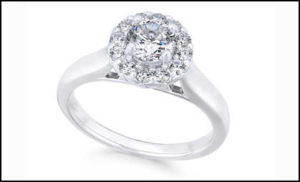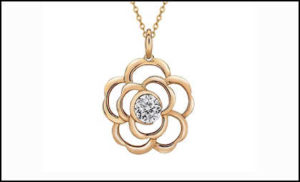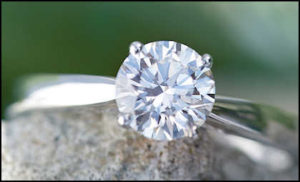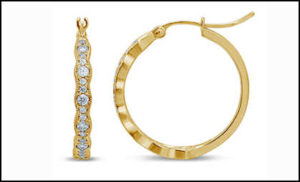Sustaining Diamonds Sparkle
Demand for diamonds is at an all-time high.
Whether consumers were shopping for themselves or loved ones, the jewelry sector experienced some of the strongest year-over-year and year-over-two-year growth, reports Mastercard SpendingPulse.
During the 2021 holiday season, from Nov. 1 through Dec. 24, jewelry sales were up 32% year-over-year, and 26% year-over 2019, finds Mastercard. Retail sales overall grew 8.5% year-over-year and 11% compared to 2019, with online sales up 11% over 2020, 61% compared to 2019.
De Beers Group’s, in its 2021 Diamond Insight Report, tracked performance across the diamond industry for 2020 and the first half of 2021 and found that consumer demand for diamonds grew 40% year-on-year in the first half of 2021, or about 15% to 20% on an annualized basis compared with 2019.
 Initial reports hail diamond jewelry a bestseller for the year and holiday season, both natural and lab grown. Consumers have not been traveling much in the past two years and with the additional disposable income, jewelry is the most sought-after product, underscores Sagar Manilal, who manages sales for Indigo Jewelry in New York City. “Limited weddings and smaller gatherings happening in the past few years have allowed more income to be spent on the right ring.”
Initial reports hail diamond jewelry a bestseller for the year and holiday season, both natural and lab grown. Consumers have not been traveling much in the past two years and with the additional disposable income, jewelry is the most sought-after product, underscores Sagar Manilal, who manages sales for Indigo Jewelry in New York City. “Limited weddings and smaller gatherings happening in the past few years have allowed more income to be spent on the right ring.”
Demand for diamonds is at an all-time high, cheers Michael Lerche, president of Goldstar Jewellery, based in New York City. “Diamond jewelry sales increased at record levels in 2021, beating 2020 and 2019 by double digit gains. All jewelry categories saw increases, particularly in bridal, anniversary and men’s jewelry.” Lab-grown diamonds, he says, also is experiencing an increase in sales and will continue to do so, he adds, noting that prices in the category are unstable.
The high demand for diamonds throughout last year, coupled with less diamonds being manufactured, is causing a rise in diamond prices that will affect retail in 2022, says Lerche. “Some areas of diamond supply are becoming harder to source, mostly in the lower, commercially priced goods.”
The increase in prices is driven by strong demand for jewelry in the U.S. and China, set against limited supply, as diamond mining and cutting remain low, reports recent market research by IndexBox.
“Natural diamond prices are increasing dramatically due to the high demand and limited supply that is due to the fixed number of manufacturers and cost of manufacturing. It is the same for natural and lab grown,” says Manilal.
In the first quarter of 2021, global production for rough diamonds fell by 22% to 24 million carats due to suspension at the Canadian Ekati diamond mine, the closure of Australia’s Argyle mine, and the decrease in activity at other large mining companies.
Rough diamond prices started rising in July, and then the outbreak of Omicron in diamond mining regions of South Africa and Botswana pushed up prices another 20%, reports Economic Times in December. Polished prices have gone up 10% to 15%, but a further increase is required to maintain profitability of the units.
With a spike in Covid-19 cases, India introduced quarantine restrictions, which led to a drop in factory utilization by 50% to 70%, an outflow of migrant workers, and a decrease in the volume of diamond cutting and polishing operations, reports IndexBox. The sharp increase in rough diamond prices inspired diamond exporters to decrease their rough purchases, reducing the need for cutting and polishing, which adversely affected the diamond workers in Surat.
“The close of the Argyle mine, which predominantly supplied SI and lower quality diamonds, is causing prices to increase in lower quality diamonds,” says Manilal. “Cutting SI and lower quality diamonds have a higher risk of breakage than better quality diamonds, the manufacturer gets paid about the same irrespective of the diamond quality, so higher quality diamonds have been made due to limited manufacturing capabilities due to COVID restrictions.”
Manilal is seeing price increases up to 50%. “We’re seeing bigger price corrections in smaller goods, mostly SI quality and lower, with increased demand and limited supply. I think these prices are here to stay.”
Lenny Kramer for Leo Schachter Diamonds in New York City concurs that prices have gone up as evidenced by DeBeers’ and other producers’ price increases, market activity, as well as several recent Rapaport price increases in both rounds and fancies. “We’re at a critical crossroads where the products we used to price at X are now pricing X++. Will jewelers buy? Will consumers buy?” It remains to be seen if these increases are sustainable.
Inventory management, Manilal concurs, will be the biggest challenge this year. Most notably as 2022 is expected to be a banner year for weddings.
Lab Grown Here to Stay
As prices rise in natural mined diamonds, lab-grown diamonds, which have also experienced phenomenal sales growth, is attracting consumers interested in bigger, better and more affordable diamond choices.
“Consumers come in with a certain budget and aspirations in mind, and when compared to a mined stone, the lab-grown diamond gives them an option,” says Cora Lee Colaizzi, director of marketing and catalogs and senior merchandiser for Quality Gold (QG), Fairfield, Ohio.
The main purchase driver for lab-grown diamonds, multiple research studies have found, is that consumers like that they can get a bigger, better-quality lab-grown diamond for the same price as a smaller mined diamond.
Fueled by rising consumer demand and the opportunity to restore healthy margins in the supply chain, engagement rings, a category that had been stripped of profitability in recent years, has become the foundation for lab-grown diamonds in the U.S. market, which represents about 80% of world consumption.
While natural-mined diamonds continue to be the most popular type of engagement stone, nearly one in four engagement rings in 2021 featured a man-made center, up 11% in the past two years, cites The Knot, based on a survey conducted in November of 5,000 U.S. couples who became engaged between January and November 2021.
 Diamond innovation is what Leo Schachter Diamonds is known for. Brands like THE LEO diamond, cut visibly brighter using patented technology strategically placing additional facets to maximize light return (66 facets). It brought this innovation to the First Light Diamond several years ago and recently launched the new LEO LEGACY brand of lab-created diamond engagement rings for Kay Jewelers. “Lab-grown diamonds afford the opportunity for the consumer to expand upon their choices yielding the retailer a potentially higher margin,” says Kramer. “Given this opportunity, especially in our industry, we are responding by offering a quality product that stays true to our brand.”
Diamond innovation is what Leo Schachter Diamonds is known for. Brands like THE LEO diamond, cut visibly brighter using patented technology strategically placing additional facets to maximize light return (66 facets). It brought this innovation to the First Light Diamond several years ago and recently launched the new LEO LEGACY brand of lab-created diamond engagement rings for Kay Jewelers. “Lab-grown diamonds afford the opportunity for the consumer to expand upon their choices yielding the retailer a potentially higher margin,” says Kramer. “Given this opportunity, especially in our industry, we are responding by offering a quality product that stays true to our brand.”
Retailers are buying a considerable amount of loose lab-grown diamonds to use in custom designs, reports Colaizzi, who spoke about the lab-grown diamond market in a podcast for The Plumb Club. But even more have been asking for finished lines set with lab-grown diamonds, and also paired with lab-grown color stones. “Retailers would not be doing that if consumers were not asking for it.”
Regarding the question of the long-term value of lab-grown diamonds, Colaizzi says the matter has yet to be settled, as the product is still relatively new on the market. “There is a value. What the future holds, it is too early to predict. The pros and cons should continue to be discussed so consumers are educated.”
Embracing Sustainable Strategy
What is most important for companies engaging in the diamond and jewelry industry is to embrace a strategy for sustainability in their business.
Sustainability considerations now rank on par with price and design for global consumers when purchasing diamonds, according to new research published last fall by De Beers Group in its eighth annual Diamond Insight Report, titled “Sustainability: shaping the future of the diamond sector.”
The study ranks fine jewelry third, after only food and clothing, as the category most frequently purchased on the basis of sustainability considerations, with one in five consumers recently buying jewelry because of its sustainability credentials. When it came to diamond jewelry, the study found sustainability considerations a key factor for consumers in all markets.
 These trends are being led by the younger generations, with 30% of Millennials indicating they have purchased jewelry with sustainability credentials as part of its branding, compared with only 8% of Baby Boomers. Sustainability considerations were higher among consumers with a higher education (67%), and for those from affluent backgrounds (70%).
These trends are being led by the younger generations, with 30% of Millennials indicating they have purchased jewelry with sustainability credentials as part of its branding, compared with only 8% of Baby Boomers. Sustainability considerations were higher among consumers with a higher education (67%), and for those from affluent backgrounds (70%).
“This is a cause close to the hearts of the younger generation and Millennials are leading the charge. Their impact on global purchasing shows it is something our industry should not only take seriously, but weave into the DNA of our own actions,” says Charles Stanley, president of De Beers Forevermark US, a guest during a Plumb Club podcast with the New York-based diamond and jewelry manufacturer KP Sanghvi. “Millennials are showing a hunger for the brands, retailers and products they buy to showcase their own impact on these issues.”
Sustainability-conscious consumers also revealed in De Beers data that they are prepared to pay more for diamonds with evidence of sustainability credentials, with 56% willing to pay between 10% and 20% more, and nearly 17% open to paying 25% or more. This also was found in a survey of over 1,000 U.S. jewelry consumers by The Plumb Club in 2021 Twenty percent of respondents rated it a 10, most important on a scale of 1 to 10 that their jewelry be responsibly sourced (6.5 was the average), with 72% indicating they would be willing to pay a moderate to great deal more for a piece of jewelry that was sustainably sourced.
“The era of corporate sustainability strategy has arrived and it’s entrenching itself as fundamental to the basic workings of all business, and is integrated into the bottom line,” says Mark Hanna, CMO for Richline Group, leading precious metals and materials manufacturer based in New York City. Since starting down this road 16 years ago, Hanna says he has tried to consider the materiality of efforts and has focused on the importance of “return on responsibility” or ROR, and the collective benefits for a company to better the world.
 Responsibility and sustainability efforts can dramatically change people’s perspective of companies. Business leadership sets the tone of what the ethics and values are. “Your social purpose should be a priority and communicated to customers, associates and stakeholders,” says Hanna, a vocal activist for sustainability in the jewelry industry, who shares insights in a recent Plumb Club podcast. “Define what return on responsibility (ROR) means to you and your company, and create a written, shared code of ethics to guide those with whom you work, including suppliers.”
Responsibility and sustainability efforts can dramatically change people’s perspective of companies. Business leadership sets the tone of what the ethics and values are. “Your social purpose should be a priority and communicated to customers, associates and stakeholders,” says Hanna, a vocal activist for sustainability in the jewelry industry, who shares insights in a recent Plumb Club podcast. “Define what return on responsibility (ROR) means to you and your company, and create a written, shared code of ethics to guide those with whom you work, including suppliers.”
